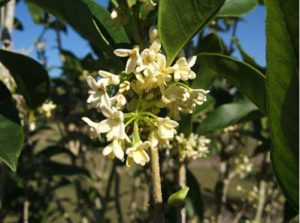When it comes to choosing plants for my yard, I follow my nose. And I have found nothing is more aromatically exquisite than the Osmanthus fragrans, tea olive tree.
The tea olive is a tree, reaching heights of 20 feet or more, but since it is slow growing, it is usually pruned and kept as a shrub.

The tea olive prefers a well-drained soil and is fairly drought tolerant once established. It will thrive in full sun or partial shade, however, too much shade can cause the shrub to become spindly.
The glossy green leaves serve as the perfect backdrop to the tiny white blooms that emerge both late in the fall and early in the spring. Don’t let the flower size fool you. Although the blossoms are small and inconspicuous, the fragrance is powerful and intoxicating.
The tree is not a native plant, but it has been evaluated using the UF/IFAS Assessment of the Status of Non-Native Plants in Florida’s Natural Areas (Fox et al. 2005). This species is not documented in any undisturbed natural areas in Florida. Thus, it is not considered a problem species and may be used in Florida.
This is a subtle plant which should be used more often in southern landscapes and is available in most nurseries. If you prefer scented shrubbery, you won’t be sorry.
For more information about the tea olive, visit https://edis.ifas.ufl.edu/publication/ST425 or contact your local UF/IFAS Extension office.
Sherry Mansfield
Master Gardener Volunteer
Source: UF/IFAS Pest Alert
Note: All images and contents are the property of UF/IFAS.



